As an Amazon Associate I earn from qualifying purchases.
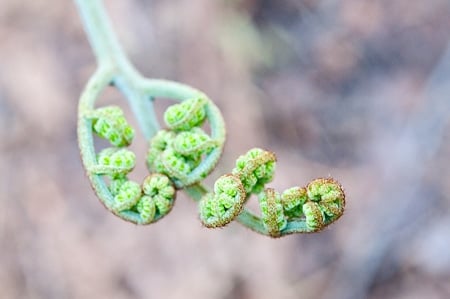
I eat a known carcinogen every spring. But then again, chances are, so do you.
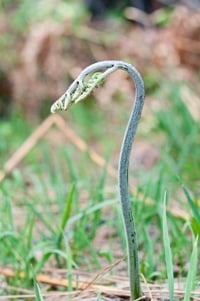
Few wild plants are as polarizing as bracken fern, Pteridium aquilinum. It is a global species, living everywhere but the harshest deserts and the coldest tundra. Here in California, it is ubiquitous. I find its fiddleheads — odd looking fiddleheads, like an eagle’s clenched talon — in Point Reyes as early as late February and as late as mid-June in the High Sierra.
That means if you wanted, you could eat bracken fern fiddleheads for four straight months here in California. You could, but you shouldn’t.
Bracken fern does indeed contains carcinogens, that much is clear. I’ve been spending a lot of time in the past week reading scientific papers with names like “Induction of Tumors in ACI Rats Given a Diet Containing Ptalquiloside, a Bracken Carcinogen.” Breezy reading, this. But the slog has been worth it, if only because I refuse to trust the internet and my fellow foraging writers outright. Bracken is so controversial you will see them writing statements ranging from “eat it as much as you want, it’s fine,” to “never, ever, ever eat bracken, raw or cooked.”
And like most black-and-white statements, both are wrong.
After a pretty exhaustive — and exhausting — survey of the literature, it seems pretty clear that a typical forager’s diet of bracken fiddleheads, blanched and sauteed with lots of butter (or whatever) is perfectly safe. Before you start shouting at me, let me explain.
The primary villain lurking within bracken fern is a substance called ptalquiloside. It is, by all accounts, nasty stuff. And bracken fiddleheads are packed with it, up to 0.8 percent by dry weight, according to some studies. But therein lies the first caveat: A raft of other studies shows that ptalquiloside levels vary wildly in bracken stands. Some in New Zealand were even found with none of the stuff at all. So you really have no idea how much — if any — of the carcinogen lies within your pretty fiddlehead.
It is abundantly clear, however, that if you eat raw bracken fiddleheads in the woods you will probably ingest ptalquiloside. And that’s not good eats.
But ptalquiloside has two properties that are of interest to us:
- First, it is water soluble. That means if you soak bracken fiddleheads in cool water (cool to keep them crunchy), and change that water every so often, you will greatly reduce the level of ptalquiloside in the fiddlehead; the Japanese often eat bracken this way.
- Second, ptalquiloside is notoriously volatile at normal temperatures. The pure stuff degenerates at room temperature, which is why the scientists doing the rat studies store their palquiloside at -20 degrees Celsius. Once exposed to boiling temperatures, the carcinogen denatures almost completely. Salt and baking soda increase this effect.
What this means is that a very normal cooking process for fiddleheads — blanching in salty water, then shocking in ice water, then sauteeing — renders the fiddlehead close to harmless.
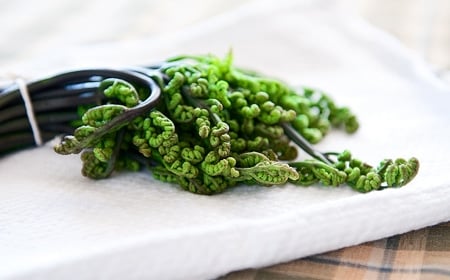
Note that I say “close to harmless.” The reason we know that bracken can cause cancer is not only because of all sorts of livestock studies — cows sometimes eat the fully grown fronds and get urinary tract cancers — but also because bracken is widely eaten in Korea, Japan and parts of China. And when I mean “widely,” I mean almost every day in some cases. Bracken (gosari) is a classic part of bibimbap, one of the most famous Korean dishes there is.
Indeed, my friend and fellow forager Langdon Cook likes to eat his bracken Asian style.
Most of the research has been done by Japanese and Koreans, searching for clues as to why they seem to have high rates of throat and stomach cancer. Apparently there are a kaleidoscope of reasons, and habitual bracken-eating is among them. Like anything, ptalquiloside’s poison is in the dose. The body can process out only so much of the stuff, and constant eating of bracken puts too much ptalquiloside in the system — that’s what causes cancer.
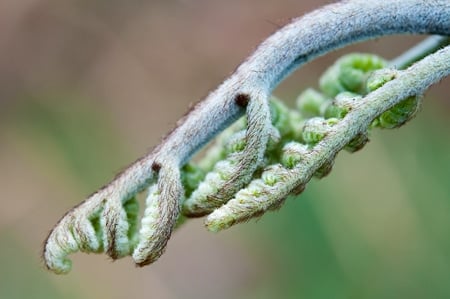
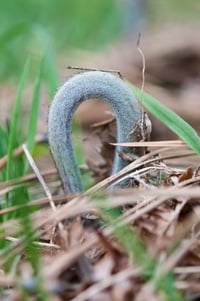
I know what you are saying. Why even mess with this crazy bracken thing? Why even put myself at risk?
Several reasons. First, bracken tastes wonderful, like asparagus, almonds and Tuscan black kale all rolled into one. Second, eating bracken is akin to drinking alcohol: Done responsibly, it is enjoyable and perfectly safe. But just as you would not rationally decide to drink a case of beer every day for a month, you would not rationally choose to eat a big plate of bracken ferns every day during the fiddlehead season. The carcinogen is no stronger than that in alcohol, and many of us drink that every day.
I choose to eat bracken fiddleheads. How often? Maybe a handful of times a year. Go for it. Eat them once and you will see what all the fuss is about. Just remember your Aristotle: All Things in Moderation.
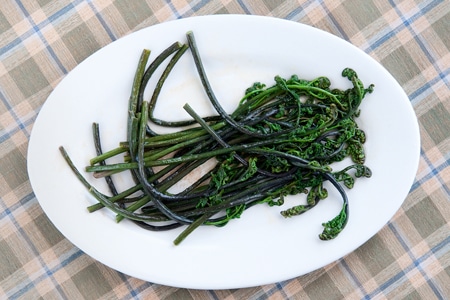
[recipe_name]Bracken Fiddleheads with Butter[/recipe_name]
[summary]Bracken fern is as good to eat as it is beautiful, but you need to take some special steps in cooking it to diminish its harmful properties. Once you do this, it is best to just simply cook these pretty things and enjoy their flavor, which is a combination of asparagus, almonds and kale. Truffle butter seemed like a natural choice as a flavoring — regular butter and truffle salt is a good alternative. No truffle products? Just use the best butter you can afford and a nice fleur de sel. Splurge! After all, you should only eat bracken a few times a year, so enjoy it![/summary]
[yield]Serves 2.[/yield]
Prep Time:[preptime time=1H] 1 hour[/preptime]
Cook Time:[cooktime time=5M] 5 minutes[/cooktime]
- [ingredient]3/4 to 1 pound young bracken fiddleheads[/ingredient]
- [ingredient]Salt[/ingredient]
- [ingredient]3 tablespoons truffle butter[/ingredient]
[instructions]
- Trim the bracken fiddleheads to an even length. Bring a large pot of water to a boil and add enough salt to make it taste like the sea. Fill a large bowl with ice water. Boil the bracken for 2 minutes, then plunge into the ice water. let them sit in the water for 45 minutes. Pat dry.
- Heat half the truffle butter in a large saute pan over medium-high heat. Saute the fiddleheads for 4-5 minutes, flipping them from time to time. Sprinkle some salt over them. Turn off the heat and add the remaining butter. Swirl to coat the fiddleheads with the butter as it melts. Eat at once.
[/instructions]
More Recipes For Foraged Foods
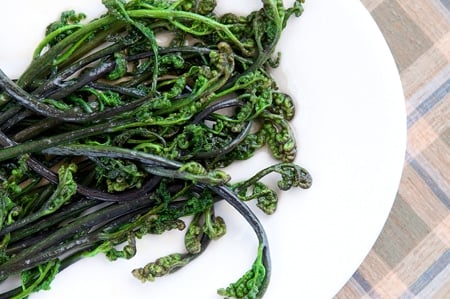




I’m making Korean Mung bean and bracken pancakes tonight. The recipe I am following recommended boiling for 30m and letting it soak for 24 hours after so it seems like I should be pretty safe. Thanks for the info.
I stopped smoking because of the carcinogens in smoke. And though I only drink occasionally, alcohol is not a carcinogen. I’m sorry, but even if it tastes like pumpkin pie, the fact that carcinogens even existed in bracken is enough for me to politely decline the offer to consume it. I tend to stay away from carcinogens and don’t really want to mess around with them.
I have recently completed a military survival course and they told us that you can eat the baby tips of the plant without any problems. Maybe they figure it will keep you alive today so you can fight 2morrow and whatever happens to you later on, we’ll you get that.
I had bracken fern last year when I visited a good Chinese friend of mine. It was very good. A year later, I am on my second trimesters and I am crazy craving for that bracken fern dish. My friend made it for me and ate it very well. After doing some reacher, I am little bit nervous. Is it safe for a pregnant lady to eat it.
Kim: That is a question above my pay grade, sorry! Can’t help you either way on that one…
Damn! I just found a great source in Hilo and now this. I’ve never seen it up here in Volcano, must be too high. I won’t be eating it as much as I want to.
I been eating bracken fern all my life and still alive at 43 yrs old . So people’s like Andrew Zimmer said if it looks good eat it. Enjoy good dish.
I am from New Zealand and bracken fern is a traditional Maori food; they also eat young shoots but use the roots of the fern also. The roots are safer and more versatile. If you want to learn how to use bracken as a food then you need to check out traditional Maori food in New Zealand. Enjoy, Dave
WOW, what a string of interesting, informative and educational responses on the plant. Although a lover of good and interesting food and one who has sampled all eatables and unusuals in different corners of our planet, I’ve certainly not heard of bracken fern, neither its English name nor its Chinese equivalent ?? (jue cai). A quick check in my Oxford Dictionary gives bracken as a large fern, but the word ? as “faint, lose consciousness or fall into a coma”. Hence by the same token, ?? would mean “vegetable that makes one faint, lose consciousness or fall into a coma.” Having been introduced by some of you of the extraordinary taste of bracken fern, I’ll brave myself to try warabi mochi, the next time I visit a Japanese restaurant.
How very interesting and informative! I grew up in Ontario, where we picked our own fiddleheads from the Ostrich fern (Matteuccia struthiopteris), and although I know bracken was eaten by the indigenous peoples (I live in BC now), I never thought much about how they were eating it. Another great wild food to forage for! Can’t wait for spring.